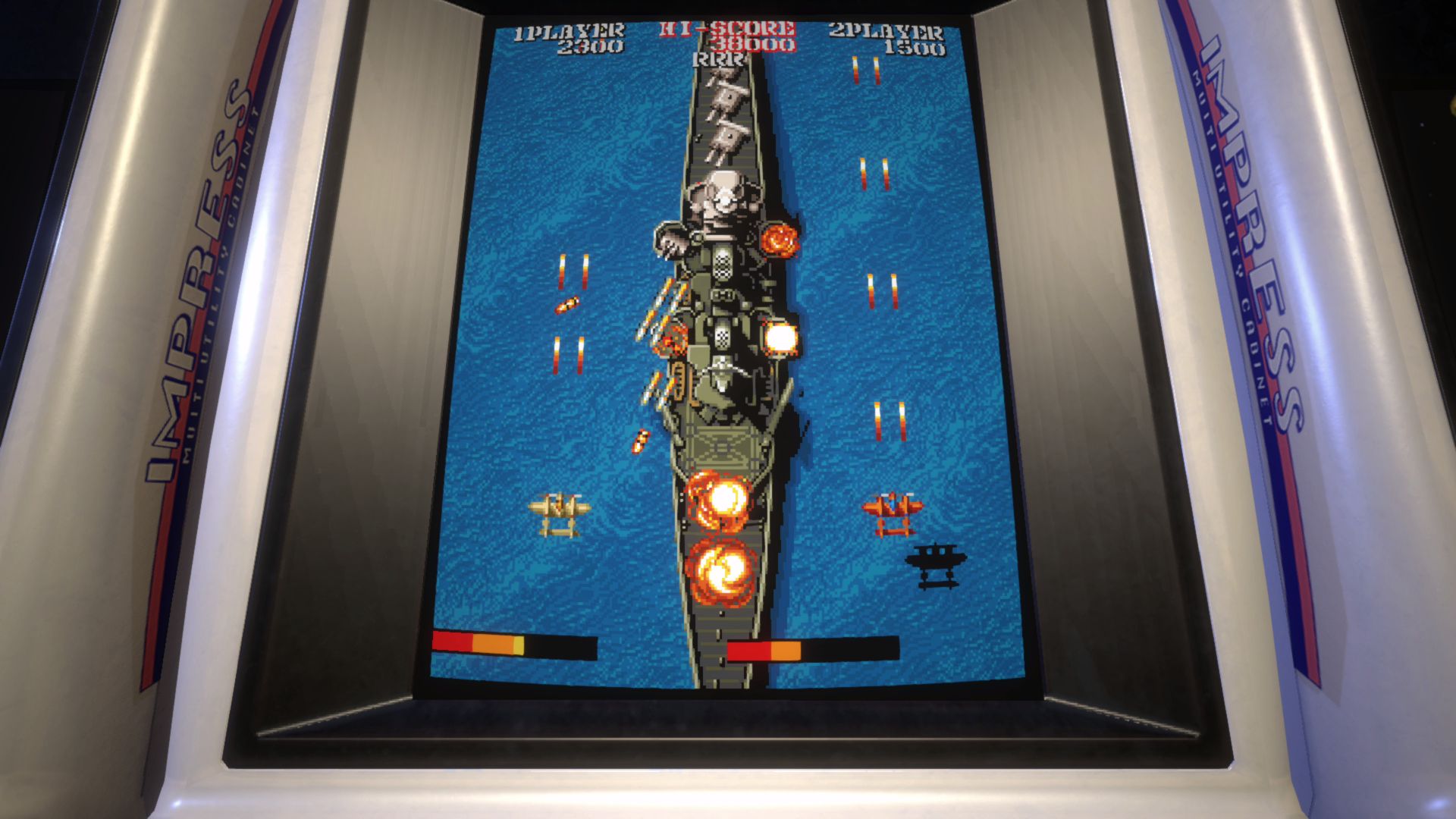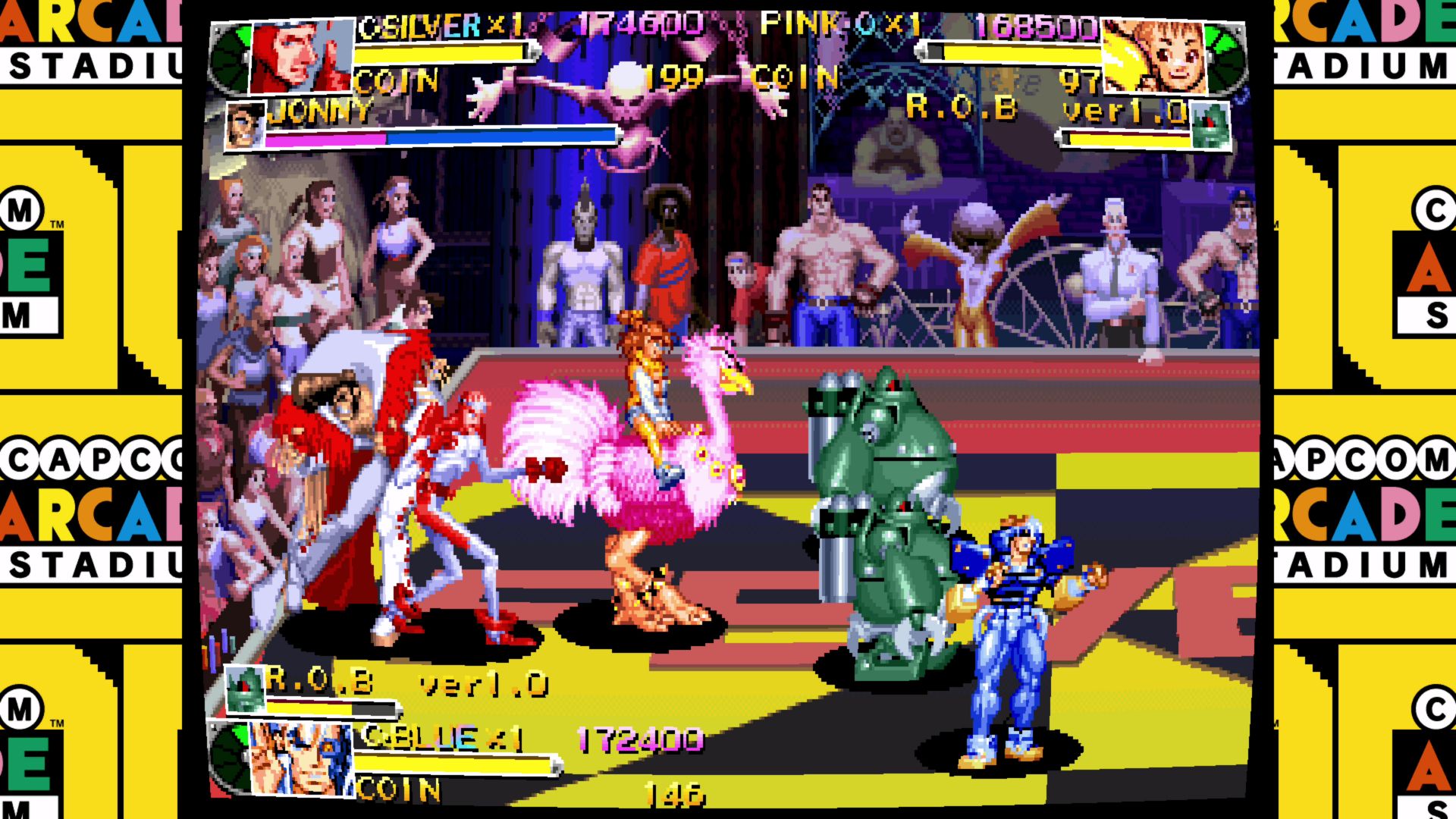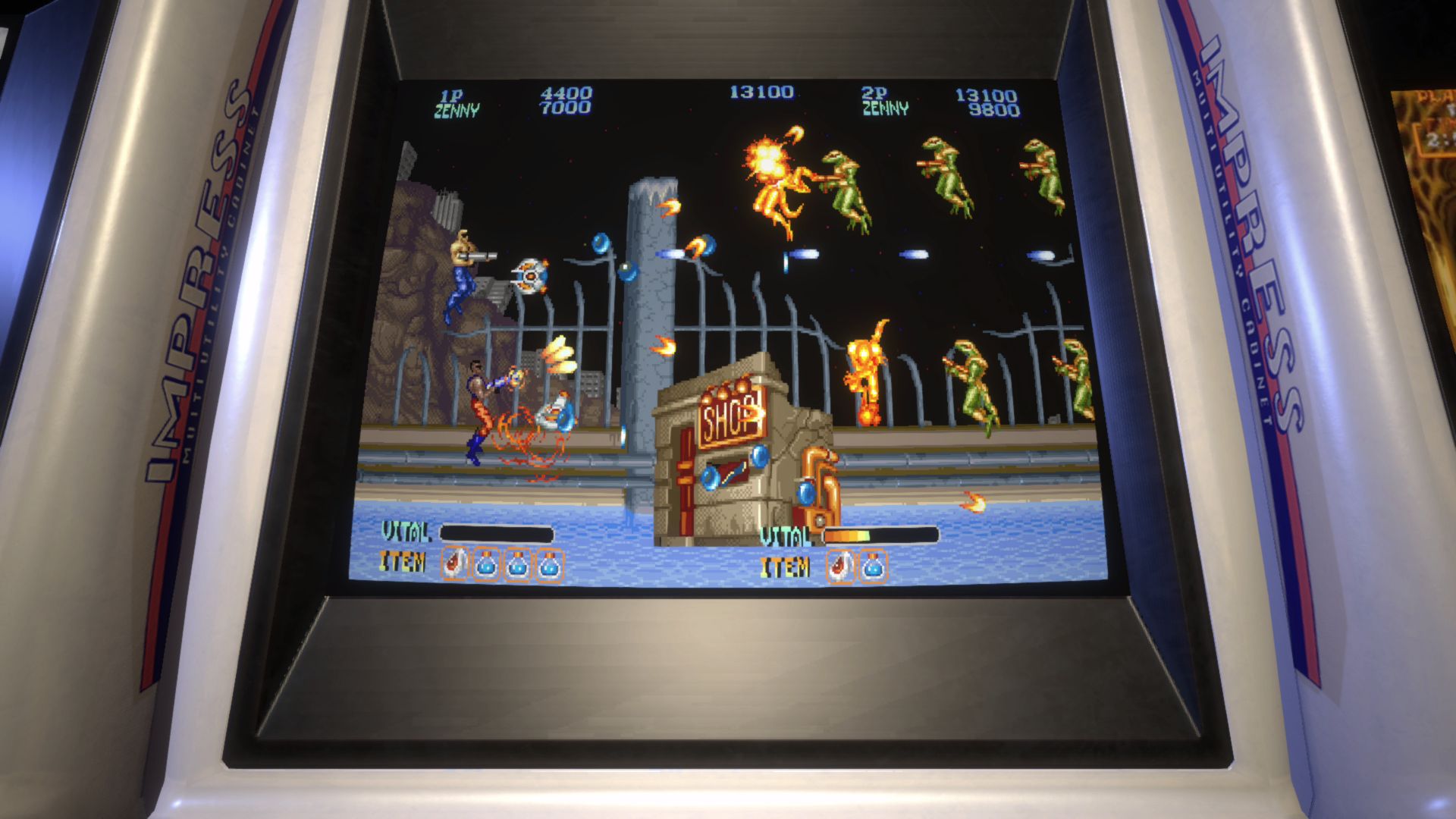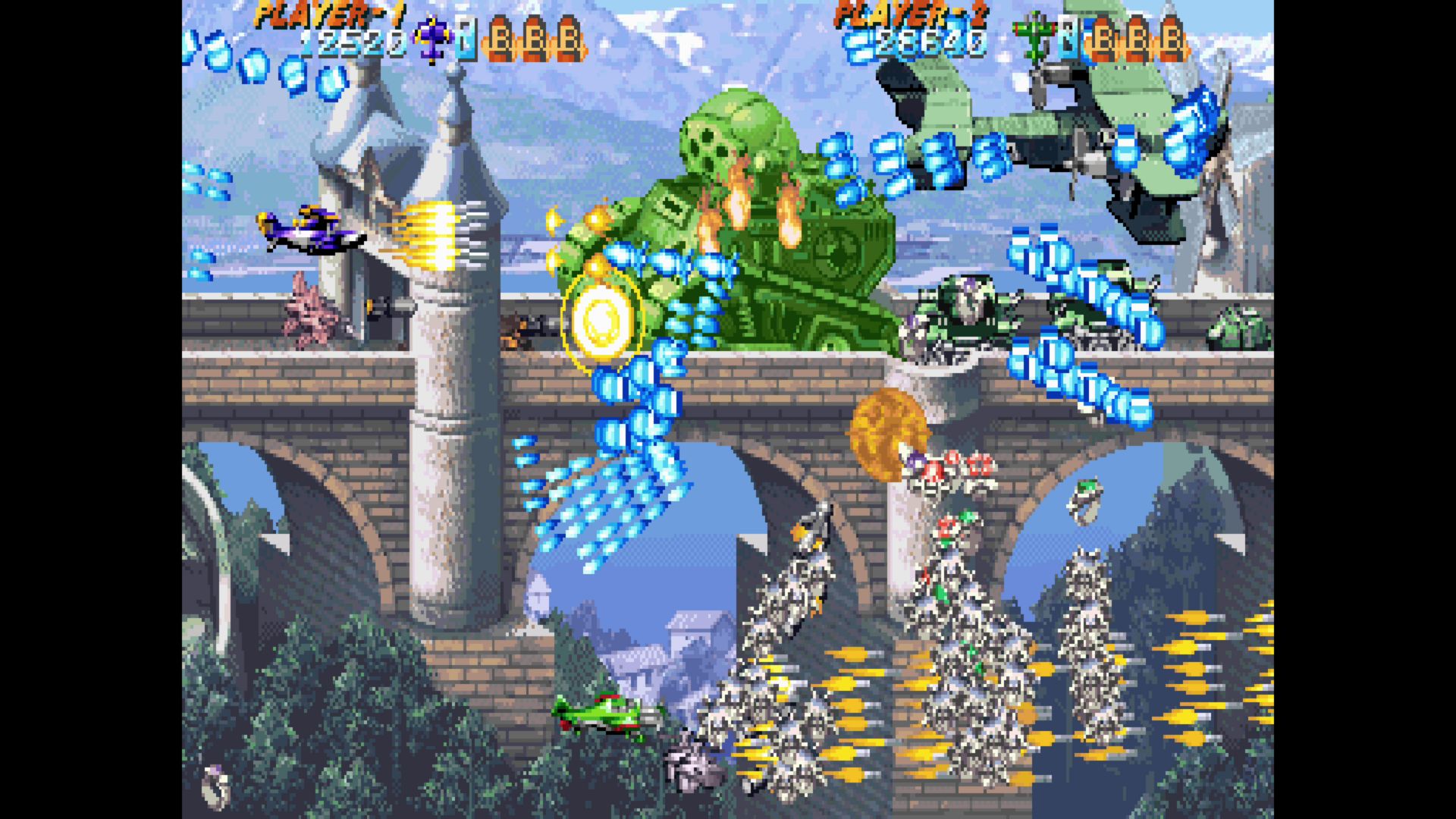Now that Capcom Arcade 2nd Stadium is here, it’s time for us to finally review the first game. Capcom Arcade Stadium is a collection of 32 classic arcade games that were originally released from 1984-2001. The various titles can be purchased as a full collection or piecemeal, with the base software and 1943, a co-op shoot ‘em up, available as a free download. Playing and writing about all 18 of Capcom Arcade Stadium’s cooperative multiplayer games was no small feat, but we’ve done just that for this comprehensive co-op review.
As mentioned before, Capcom Arcade Stadium consists of 32 games that can be bought alone, in packs, or as a single purchase. See our full games list article for a discussion of the individual DLC packs as well as alphabetical and release date sorting of the library. For this review, we’ll describe the co-op games in detail and list the non-cooperative games afterward.

1943: The Battle of Midway
Co-op games
- 1941: Counter Attack (1990, 2 players): The third game in the 19XX vertically-scrolling shoot ‘em up series, players pilot planes through a World War II setting. The graphics have greatly improved, level design is quite dynamic, and players have a life meter. Bumping against walls causes the plane to spin rather than take damage – a unique mechanic.
- 1943: The Battle of Midway (1987, 2 players): The sequel to vertically-scrolling shoot ‘em up 1942, this one adds co-op. Subsequent games overshadow 1943, but it’s still a solid, low-frills shmup set in World War II.
- 1944: The Loop Master (2000, 2 players): The fourth game in the 19XX series, this installment retains the vertically-scrolling gameplay but loses the “tate” monitor orientation in favor of a horizontal monitor. The change in monitor orientation creates a wide playing field.
- 19XX: The War Against Destiny (1995, 2 players): The final arcade game in the 19XX series (though a console sequel followed later), 19XX returns to a ”tate” monitor orientation. Players have three planes with varying stats to choose from. The camera is zoomed in more than previous entries and shifts with the player’s position, potentially causing motion sickness.

Battle Circuit
- Battle Circuit (1997, 4 players): Capcom’s final arcade beat ‘em up, this one features an anime-style sci-fi/superhero theme and 5 playable heroes. A unique upgrade system allows players to buy new moves between levels. Despite the poor English translation, the colorful visuals and general wackiness make for a decently memorable brawler.
- Captain Commando (1991, 4 players): The titular hero debuted in the 1985 shoot ‘em up, Section Z, also included in this collection. This time, he’s one of four wacky playable characters, and the game is set in the future of Final Fight’s Metro City. Rideable mechs, equippable guns and other weapons, and occasional auto-scrolling stages are some standout features. Captain Commando shares a lot of the same zaniness as Battle Circuit.
- Carrier Air Wing (1990, 2 players): Known as U.S. Navy in Japan, Carrier Air Wing is side-scrolling, military-themed shoot ‘em up that resembles Capcom’s U.N. Squadron (which is not included in either volume of Capcom Arcade Stadium). Players choose from three planes and can buy weapons at a shop between levels.
- Dynasty Wars (1989, 2 players): The first of two Capcom beat ‘em ups based on the manga Tenchi wo Kurau, which dramatizes China’s Three Kingdoms period – the same era depicted in Koei Tecmo’s Dynasty Warriors series. Uniquely, this game takes place entirely on horseback. Combat relies on left and right attack buttons (à la Double Dragon II), and attacks can be charged up to do more damage.
- Final Fight (1989, 2 players): Capcom’s seminal beat ‘em up significantly advanced the genre with its large sprites, 3 selectable characters, satisfying weapons, and a killer soundtrack. Some folks prefer Final Fight CD, but you can’t beat the original arcade game.

Forgotten Worlds
- Forgotten Worlds (1988, 2 players): A side-scrolling shoot ‘em up in which players control flying soldiers who can fire in multiple directions rather than a ship with limited aiming. Items can be bought from a shop during levels, too. Few shmups utilize this gameplay style, making Forgotten Worlds one of the more unique games of its genre.
- Giga Wing (1999, 2 players): A vertically scrolling shooter with a 1944-like horizontal monitor orientation, Giga Wing lets players select from four unique pilots/planes, all of whom have their own stories. Players can charge up a shield that reflects bullets, enemies drop tons of medals when defeated (which is both fun and distracting), and the graphics feature loads of detail and effects.
- Legendary Wings (1986, 2 players): A very unique shoot ‘em up that combined vertically scrolling stages with on-foot, run-and-gun stages, Legendary Wings is like nothing else. The setting mixes Greek mythology with science fiction – also different. Unfortunately, the winged heroes move too slowly compared to the lightning-quick enemies, making the game harder than it should be.
- Mega Twins (1990, 2 players): A cartoony action platformer known as Chiki Chiki Boys in Japan, Mega Twins resembles some of the Wonder Boy games. Two sword-wielding boys must battle monsters in a vaguely mythological world. Although not very well known outside of Japan, Mega Twins is quite a charming game.
- Powered Gear (Japanese version of Armored Warriors, 1994, 3 players): Armored Warriors takes place in the same universe as Cyberbots (a fighting game, also included in this collection), but this one is a beat ‘em up. Players choose from four distinctive pilots/mechs and head to various planets to battle other beautifully-drawn mechs. Mechs can pick up different parts, similar to equipping items in an action RPG. During boss battles, co-op players can even perform several different Ultra-Team-Up Attacks.

Progear
- Progear (2001, 2 players): The poorly-named Progear is a side-scrolling shoot ‘em up in which children are forced to pilot aircrafts in an attempt to overthrow an evil empire. Players select from two pilots and three gunners, the choice affecting their firepower and the game’s ending. Progear looks and plays well despite an overly complex scoring system, thanks to the shmup specialists at CAVE.
- Senjo no Okami II (1990, 3 players): The Japanese version of Mercs, this is the sequel to the top-down run-and-gun shooter, Commando. The graphics have greatly improved over the original, and the addition of co-op makes for a much better game.
- Varth: Operation Thunderstorm (1992, 2 players): A military-themed vertically-scrolling shoot ‘em up. Varth is similar to many other shmups, but it’s one of the better-looking ones thanks to numerous graphical effects and parallax scrolling.
- Warriors of Fate (1992, 3 players): The sequel to Dynasty Wars, this beat ‘em up is also based on the Tenchi wo Kurau manga. The sprites are much larger than in the original. Most fighting now takes place on foot, but players can still ride horses at times. The English translation removes the Three Kingdoms names and references, annoyingly.
